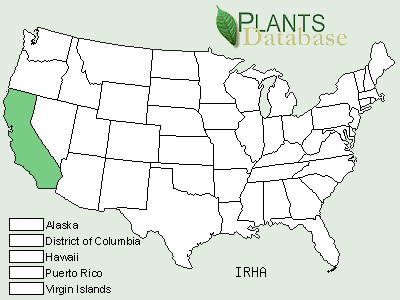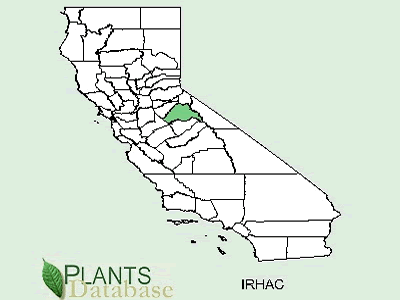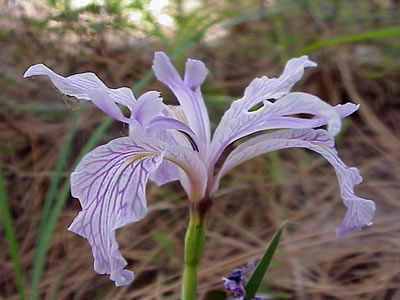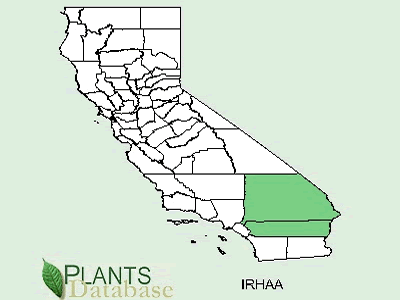Our Native Irises: Pacific Coast Irises
Iris hartwegii: Hartweg's Iris (Sierra Iris)
Hartweg’s iris occurs from the southern Cascade Range, Sierra Nevada, San Gabriel Mountains, San Bernardino Mountains, and San Jacinto Mountains.
 Hartweg’s iris is a complex species that has been sub-divided into four separate subspecies. Photo courtesy Society for Pacific Coast Native Iris.
Hartweg’s iris is a complex species that has been sub-divided into four separate subspecies. Photo courtesy Society for Pacific Coast Native Iris.
Iris hartwegii has pale yellow, creamy white flowers with prominent veins, occasionally deep yellow, lavender, or bluish-violet. The sepals are narrow, widely spreading. The petals are the same color as the sepals but with much lighter colored veins. The petals are erect and lightly spreading. The inflorescence has two to three small flowers. The leaves are basal, spreading, basal, and green with a green to faint pink base, from slender creeping rhizomes with fibrous roots; plants occur as individuals not in clumps.
Iris hartwegii is found growing in sunny to lightly shaded mixed and yellow pine woodlands and forests. from the southern Cascade Range, Sierra Nevada, San Gabriel Mountains, San Bernardino Mountains, and San Jacinto Mountains.
For More Information
Iris hartwegii ssp. hartwegii: Hartweg' Iris (Sierra Iris)
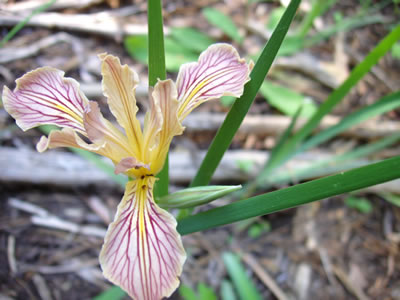 The typical subspecies hartwegii is the most common of the four subspecies. Photo courtesy Society for Pacific Coast Native Iris.
The typical subspecies hartwegii is the most common of the four subspecies. Photo courtesy Society for Pacific Coast Native Iris.
Iris hartwegii ssp. hartwegii has two pale to golden yellow flowers, rarely lavender. The sepals are narrow, widely spreading with prominent golden yellow veins. The petals are the same color as the sepals but with much lighter colored veins. The petals are erect and slightly spreading. The leaves are spreading, basal, green with a green base, from slender creeping rhizomes with fibrous roots; plants occur as individuals not in clumps.
Iris hartwegii ssp. hartwegii is found growing in sunny to lightly shaded mixed and yellow pine woodlands and forests from the southern Cascade Range south through the Sierra Nevada mountains.
For More Information
Iris hartwegii ssp. pinetorum: Hartweg’s Iris (Sierra Iris)
 In this image of subspecies pinetorum, we see that it is aptly named as the ground is covered with pine needles. Photo by Carol Wilson, The Genus Iris.
In this image of subspecies pinetorum, we see that it is aptly named as the ground is covered with pine needles. Photo by Carol Wilson, The Genus Iris.
Iris hartwegii ssp. pinetorum has two pale to golden yellow flowers. The sepals are very narrow, widely spreading with prominent golden yellow veins. The petals are the same color as the sepals but with much lighter colored veins. The petals are erect and slightly spreading. The inflorescence has two flowers that are unusual as they bloom simultaneously instead of sequentially. The leaves are spreading, basal, green with a faint pink base, from slender creeping rhizomes with fibrous roots; plants occur as individuals not in clumps.
Iris hartwegii ssp. pinetorum is found growing in sunny to lightly shaded yellow pine woodlands and forests from the southern Cascade Range south through the north and central Sierra Nevada mountains.
For More Information
Iris hartwegii ssp. columbianum: Hartweg’s Iris (Sierra Iris)
 The subspecies columbianum is extremely rare known only from a very small geographic area. Photo by Carol Wilson, The Genus Iris.
The subspecies columbianum is extremely rare known only from a very small geographic area. Photo by Carol Wilson, The Genus Iris.
Iris hartwegii ssp. columbianum has three, rarely two, pale creamy yellow flowers. The sepals are widely spreading with prominent golden yellow veins. The petals are the same color as the sepals but with much lighter colored veins. The petals are erect and slightly spreading. The leaves are spreading, basal, green with a slightly reddish base, from slender creeping rhizomes with fibrous roots. Plants occur as individuals, not in clumps.
Iris hartwegii ssp. columbianum is found growing in sunny to lightly shaded yellow pine woodlands and forests in the high Sierra Mountains in Tuolumne County near the community of Columbia.
Conservation Concern
Iris hartwegii ssp. columbianum is ranked as imperiled (G4T2): 6 to 20 populations or 1,000 to 3,000 individuals or 2,000 to 10,000 acres.
For More Information
Iris hartwegii ssp. australis: Hartweg’s Iris (Sierra Iris)
Iris hartwegii ssp. australis occurs from the eastern San Gabriel Mountains, San Bernardino Mountains, and San Jacinto Mountains and is geographically isolated from the other subspecies.
Iris hartwegii ssp. australis has two, purple to bluish-violet flowers. The sepals are widely spreading with prominent purple veins. The petals are the same color as the sepals but with much lighter colored veins. The petals are erect and slightly spreading. The leaves are spreading, basal, green with a slightly pink to reddish base, from slender creeping rhizomes with fibrous roots. Plants occur as individuals, not in clumps.
Iris hartwegii ssp. australis occurs from the eastern San Gabriel Mountains, San Bernardino Mountains, and San Jacinto Mountains and is geographically isolated from the other subspecies and is found growing in lightly shaded yellow pine woodlands and forests.


